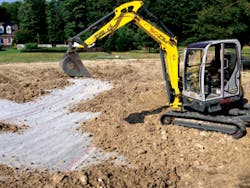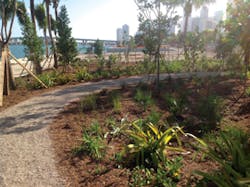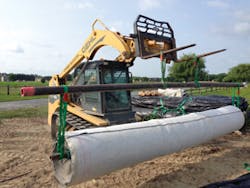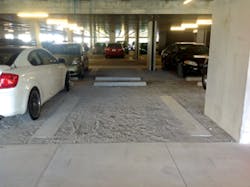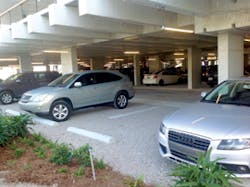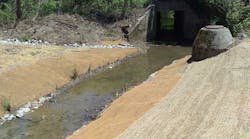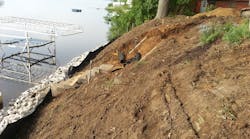Geosynthetics are amazing products. They range from sheets that are less than a millimeter thick to three-dimensional cells. They may be pervious or impervious, woven, knitted, stitched, matted, or extruded.
Made of polymer materials such as polyolefin, polypropylene, high-density polyethylene (HDPE), and low-density polyethylene (LDPE), they’re thinner, lighter, and easier to install than sand, gravel, and clay. They have higher resistance to stress, but they’re more sensitive to ultraviolet light. For this reason, they are commonly UV-stabilized.
Geosynthetics serve five different functions: separation, reinforcement, filtration, drainage, and confinement. Their uses range from reducing soil erosion and containing stormwater to reinforcing retaining walls and lining ponds. When they’re combined with natural materials such as gravel, or soil and vegetation, they may be decorative as well.
There are eight main categories of geosynthetics. Each category may serve more than one function, and two or more categories may be used together.
Geotextiles are made of polypropylene fibers that are either woven (which includes knitted and stitched) or nonwoven. They serve at least one of the five functions, and often more than one at a time.
Nonwoven geotextiles are matted together and have a random three-dimensional structure. They’re highly permeable. They may be used to drain green roofs, as well as to separate subsoils from gravel and to filter water, for example, behind retaining walls, and in dams, canals, and reservoirs.
Woven geotextiles are much less permeable than nonwoven ones. They are used primarily to stabilize soil and to separate subsoils from gravel or paved surfaces. They may have a secondary function for filtration.
Geogrids are made of polymers formed into open, gridlike configurations by stretching, by weaving or knitting, or by laser or ultrasonic bonding. They may be composed of two or three layers, which are designed to confine a fill material such as crushed aggregate.
Uniaxial geogrids have strength in a single direction. They are used primarily to stabilize steep slopes, or in retaining and mechanically stabilized earth (MSE) walls and embankments.
Biaxial geogrids have strength in two directions. They are used most often to stabilize soil and paved and unpaved roadways.
In the park, the GravelPave is adjacent to vegetation to create a soft edge.
Geocells, or cellular confinement systems, are extruded from polymers into strips that are welded together ultrasonically. The strips are expanded to form a three-dimensional cellular network that is relatively thick and durable as well as flexible and lightweight. The cells may be filled with compacted soil, gravel, or concrete.
The systems perform many functions, often more than one per application. They reduce soil erosion, provide drainage, distribute loads over a wider area, reinforce slopes and road bases, and provide stable surfaces for walking or driving.
Geosynthetic clay liners are a combination of two geotextiles and bentonite clay. The clay is rolled into thin layers and encased between the geotextiles. All three layers are needle punched or stitched together. The clay liners are used to contain water in tunnels, dams, canals, and ponds.
Geomembranes are thin, flexible, impervious sheets of either HDPE or linear low-density polyethylene (LLDPE). They are used primarily to contain water in dams, canals, and ponds; as liners in tunnels; and in green roofs to separate plant roots from the roof of the structure.
Geonets and geospacers are made of polymers that are extruded into netlike configurations. The network forms a sheet that can carry relatively large flows of liquids or gas. They may be three-dimensional. They serve primarily as drainage in conjunction with other geosynthetics such as geocomposite sheets and geotextiles. They’re used on rooftop gardens, behind retaining walls, and in dams, canals, and reservoirs. In areas where there is soil erosion, they may filter runoff to an underground basin or to a layer of rock or aggregate.
Geofoam blocks or slabs are created when polystyrene foam expands, resulting in a network of rigid, closed, gas-filled cells. Geofoam reduces vertical and lateral earth pressures on structures such as retaining walls and embankments. It also provides very lightweight void fill on structures such as highways, parking lots, and green roofs.
Geocomposites are a combination of two or more geosynthetics. They also may include soil, clay, or gravel.
The variety of possible combinations gives geocomposites the greatest variability of geosynthetic functions. They perform all five: separation, reinforcement, filtration, drainage, and containment.
For example:
- geosynthetic clay liners, a combination of polymers and clay, to contain water
- eocells, or cellular confinement systems, a combination of polymers and soil or gravel, to contain soil
- geonets incorporated with a geotextile, often on both sides, for separation and filtration
- geomembranes incorporated with a geotextile, often on both sides, for drainage and reinforcement
- geomembranes incorporated with a geogrid to contain water with tensile reinforcement
- geotextiles incorporated with a geogrid for drainage with tensile reinforcement
Below are two projects that used geocomposites. One is Gravelpave2, a geocell system manufactured by Invisible Structures in Golden, CO. It was used for the parking garage and the pathways at the new Perez Art Museum of Miami.
The second is the Bentomat ST geosynthetic clay liner system manufactured by The Lining Technologies Group, a business unit of CETCO, whose corporate headquarters is in Hoffman Estates, IL. Bentomat ST was used to line two ponds in Lewes, DE.
Perez Art Museum of Miami
It was 2007 when designers began planning the transformation of the former Port of Miami into Museum Park, a lush urban park overlooking Biscayne Bay. The 30-acre project was undertaken with land and funding from the city and capital funds from Miami-Dade County’s Building Better Communities program. Most of the museum’s funding came from private donors.
A track-type loader held up each section of liner as a miniexcavator pulled it across the ponds. Seams overlapped by at least 12 inches.
Museum Park consists of the newly built public park and the Perez Art Museum of Miami, which opened in December 2013, just to the north of the park. The 200,000-square-foot museum was designed by Pritzker Prize-winning architects Herzog & de Meuron Basel Ltd., an architecture firm with its head office in Basel, Switzerland. Handel Architects LLP, based in New York City, served as the executive architects.
“Herzog & de Meuron is the best museum architecture firm in the world,” says Jeremy Calleros Gauger, AIA, LEED AP, senior associate designer for ArquitectonicaGEO, a Miami landscape architecture firm focused on environmentally sensitive design. Calleros Gauger was the project manager for the landscape design portion of the project.
The construction company John Moriarty & Associates built the museum, which houses international art of the 20th and 21st centuries. Construction on a second museum, the Frost Museum of Science, is due to be completed in 2015.
Calleros Gauger and the landscape design team used Gravelpave2 porous pavers for the paths, the parking garage, and the patio, which will include a sculpture garden.
“The landscaping was always part of the original building concept,” says Calleros Gauger. “The architects imagined the north edge of the park getting denser and the museum emerging from the jungle.”
Gravelpave2 porous pavers consist of a grid of cells, or cylinders, molded onto a flexible nonwoven polyester filter fabric mat. The cells are made from flexible HDPE plastic with UV inhibitors, according to Invisible Structures. HDPE resists chemicals such as road salts, motor oils, and fuels; is highly abrasion-resistant; and is unaffected by extremes in pH.
The cells hold a fill material, usually gravel, in place. The mat separates the fill from vegetation and dust in the base course.
The system transfers the point-load pressure from the top of the cells through the fill and the cells to the engineered base course. Gravelpave2 is available in black, tan, gray, and terra cotta as well as custom colors.
Although Museum Park is in a flood zone, there was no requirement to use porous pavers. Gravelpave2 was chosen for a number of other reasons, Calleros Gauger says.
Aesthetically, the gravel complements the building, which is a mix of smooth and rough surfaces, unpainted and unstuccoed.
And as a surface in the parking garage, “There’s recognition that the garage is the first thing people see,” he says. “We asked, ‘What can we do that’s extraordinary there?’ We decided that it was the texture and the sound that cars make when they drive over it.”
The Gravelpave2 system is durable enough for street-legal vehicles to park or drive on and porous enough to handle 3 inches of stormwater in less than 30 minutes, according to Invisible Structures. It’s also ADA accessible.
Another benefit of the system is that it supports healthy plant growth. The mats flex with tree roots, and because the system prevents soil compaction when vehicles drive and park below tree canopies, it allows water and air to reach plants’ root systems.
Valley Crest Landscape Companies, based in Calabasas, CA, installed the system. Crews weren’t required to excavate, so the grade stayed very similar to its natural level, Calleros Gauger says.
“There’s a 1:1 hillside up to the highway to the north. It’s reinforced with a geotextile with coir fiber to hold the plants until they take hold. That elevation is very unusual.”
Valley Crest stripped the topsoil on the flat land and removed the contaminated “hotspots” remaining from the days when oil was stored on the site. Crews created a number of depressions to slow stormwater and help with infiltration, and also redistributed existing fill that was between the museum and the park.
In the areas where Gravelpave2 was to be installed, they compacted the soil for the base course to less than 95% proctor to allow for infiltration. These areas include the parking garage, the patio, the 15-foot-wide paths leading from behind the parking garage to the elevators and the staircase of the museum; and the paths that crisscross the park, which are between 6 and 20 feet wide.
Altogether, Valley Crest installed a total of 77,000 square feet of pavers. They’re manufactured in 1-square-meter units (3.3 by 3.3 feet) and in quarter-meter units (1.65 by 1.65 feet). In the parking garage, crews installed 52,000 square feet of Gravelpave2.
“Invisible Structures was very supportive with design details and information that made our local code enforcement officers come around to the idea of having a porous parking surface,” says Calleros Gauger.
The parking garage has concrete pavement for lane markers and paths.
Concrete pavement was used for the lane markers and concrete paths through the garage to provide space for high heels to stay safely away from the gravel. “It’s Miami, after all,” he says.
The paths to the museum are bordered with concrete pavement, which delineates the paths, serves as a guide to the elevators and the staircase, and may be used as a walking surface. In the park, the Gravelpave2 is adjacent to vegetation to create a soft edge.
Valley Crest used 8,000 square feet of Gravelpave2 in the patio.
“The Gravelpave comes rolled up,” explains Calleros Gauger. “Each roll can be handled by a couple of people.” Crews rolled out the mats, facing in the same direction, and used tin snips to cut between the cells to fit the narrower areas. They connected the mats with snap-fit fasteners that are molded into them for a seamless connection.
They then anchored the mats to the base course with anchors supplied by Invisible Structures, placing the anchors as close as possible to the center of the cells.
For the fill, they used clean, angular granite chips imported from Alabama, approximately 1/8–3/8 inch in size. The local limestone isn’t hard enough, Calleros Gauger says. It’s important for the gravel to be washed and very well-graded so dust and smaller chips don’t migrate to the bottom and clog the system. The gravel must also be angular so the chips lock in place.
Valley Crest placed the fill into the cells with a front-end loader, shaking out the gravel as the machine moved forward and dragging the bucket above the cells to smooth it out the gravel as it backed up. Crews finished the placement with a stiff broom. In the smaller areas, the gravel may be placed with a wheelbarrow and a shovel.
Crews filled the cells with a total of 1 1/4 inches of gravel, which overfilled the cells by approximately 1/4–1/8 inch. The excess prevents the cells from being exposed during compaction and ensures that the wear surface is the gravel, not the cells themselves. It also provides visual cover and additional UV protection. This excess will migrate, but usually not very far, according to Invisible Structures.
Valley Crest compacted the fill with a vibrating plate compactor so that it would interlock but not hamper the drainage.
“They did a great job,” says Calleros Gauger. “We’re still working with them. It’s an ongoing process.”
For maintenance, Invisible Structures recommends that pavers in high-traffic areas and entrance lanes be checked seasonally for lowered levels of fill. The levels can be raised by sweeping gravel from other areas into these cells.
Leaves should be raked or vacuumed before they begin to decay, as organic matter will stimulate weed growth and reduce porosity.
In colder climates, Gravelpave2 withstands repeated freeze-thaw cycles and continuous subzero temperatures. Snowplow drivers should leave a thin layer of snow on the pavers, attach skids to the bottom of the blades, or use rubber blades.
“As a design process, this has been incredible,” says Calleros Gauger. “Some similar ideas will be in place with the science museum. There’s more space, so it will have a plaza and a wetland for even more stormwater detention. We’re the designer for that as well.”
Two Ponds in Lewes, DE
The city of Lewes, which was the site of the first settlement in the state of Delaware, the first state to ratify the Constitution, sits some 13 feet above sea level on Cape Henlopen, where the Delaware Bay and the Atlantic Ocean meet. Sandy beaches stretch for miles between the ocean and the bay.
When homeowners in the city wanted two decorative ponds to be built on their 6-acre property, they contacted Arbor Care Inc. in Seaford, DE, which provides landscaping and other services.
For the liners, they selected the Bentomat ST geosynthetic clay liner system, manufactured by The Lining Technologies Group, a business unit of CETCO. CETCO provides products and support around the world. Its corporate headquarters is in Hoffman Estates, IL. The liners were supplied by ACF Environmental, which has offices across the country.
The Bentomat system consists of a layer of Wyoming granular sodium bentonite clay needle-punched between two layers of chemically resistant geotextiles: a woven top layer and a nonwoven bottom layer. The bottom layer has a precision cut that allows the bentonite to migrate out and self-seal at the overlaps.
“I like these liners because they’re basically seamless,” says Chase Beach, owner of C. M. Beach Site Work in Lewes, which excavated the ponds and lay the liners with Arbor Care. “They have no holes, so they create a completely waterproof area.”
The key is the sodium bentonite, which has a high affinity for water and can swell up to 15 times its original volume when it’s wet, according to CETCO. This ability to swell allows it to seal any punctures in the geotextile that may have occurred during the installation.
In addition, the granular form of bentonite is less likely to shift during the needle-punch process. The process increases the shear resistance of the liners.
The geotextiles cushion the bentonite and protect it from punctures. They also ensure that the clay and moisture content is consistent throughout the lining.
The Bentomat system allows ponds to be built more quickly and efficiently than compacted clay liners, according to CETCO. It takes up to 150 truckloads of clay to equal the coverage of just one truckload of Bentomat. In addition, the system is less likely to be affected by freeze-thaw cycles than clay liners.
When the Bentomat system is fully hydrated, it typically has a permeability of approximately 20 times lower than a typical compacted clay liner, says John Easom of ACF Environmental.
The first pond is approximately 1,000 feet in diameter, and the second approximately 900 feet. They’re irregularly shaped and roughly 80 feet apart. Beach worked with Arbor Care to determine the slopes of the ponds.
Crews excavated to a depth of 12 feet, and by the time they were finished, the machinery had compacted the subgrade sufficiently, Beach says. Because no running water enters or leaves the ponds, it wasn’t necessary to install pipes. Crews used some of the dirt from the excavation to build small hills on the property.
The sections of liner arrived rolled up like a carpet. “The total thickness is less than one inch. They’re approximately 15 feet wide. A big roll weighs approximately 3,200 pounds,” he says.
Beach and Arbor Care lay 11,250 square feet of the liner in two days. They used a Gehl CTL85 track-type loader to hold up each section as a mini-excavator pulled it across the ponds. They ensured that the seams overlapped by at least 12 inches.
“The liners are a little bit fragile,” says Beach. “The main issue is tearing. You have to be careful with the equipment.”
Because the pond is curved, the liners were wrinkled in places when they were installed. Beach and Arbor Care pulled out the wrinkles by hand and then covered the liners with approximately 12 inches of dirt from the excavation. This kept the bentonite from overexpanding in the middle of the ponds and promoted expansion to the sides when the ponds were filled.
It’s important to cover the liners as soon as possible, says Beach. Because bentonite expands when it’s wet, “You want to make sure you cover the liner before a rainfall, or you won’t be able to backfill properly.”
After the liners were installed, crews filled the ponds with water from a well on the property and added an ocean-blue dye to the water. Algae can grow quickly in conditions where there is abundant sunlight and still water. The dye blocks some of the sunlight. Because there is no movement of water in these ponds, Beach will install a fountain in each one. As the water falls back into the ponds, it will create ripples that oxygenate the water, which also will discourage the algae from growing.
“The ponds are pretty low-maintenance,” says Beach. “You just have to re-dye them approximately once a month.”
The homeowners are very happy with them, he adds. “They look good, and the homeowners haven’t had to fill them for a year. That was the point of these liners, that the water wouldn’t infiltrate into the water table.”
